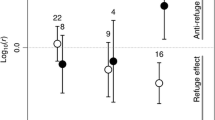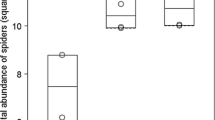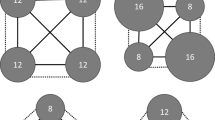Abstract
Structural features of habitat are known to affect the density of predators and prey, and it is generally accepted that complexity provides some protection from the environment and predators but may also reduce foraging success. A next step in understanding these interactions is to decouple the impacts of both spatial and trophic ingredients of complexity to explicitly explore the trade-offs between the habitat, its effects on foraging success, and the competition that ensues as predator densities increase. We quantified the accumulation of spiders and their prey in habitat islands with different habitat complexities created in the field using natural plants, plant debris and plastic plant mimics. Spiders were observed at higher densities in the complex habitat structure composed of both live plants and thatch. However, the numerically dominant predator in the system, the wolf spider Pardosa milvina, was observed at high densities in habitat islands containing plastic mimics of plants and thatch. In a laboratory experiment, we examined the interactive effects of conspecific density and habitat on the prey capture of P. milvina. Thatch, with or without vertical plant structure, reduced prey capture, but the plastic fiber did not. Pairwise interactions among spiders reduced prey capture, but this effect was moderated by thatch. Taken together, these experiments highlight the flexibility of one important predator in the food web, where multiple environmental cues intersect to explain the role of habitat complexity in determining generalist predator accumulation.




Similar content being viewed by others
References
Anderson JF (1974) Responses to starvation in the spiders Lycosa lenta Hentz and Filistata hibernalis Hentz. Ecology 55:576–585
Andow DA (1991) Vegetational diversity and arthropod population response. Annu Rev Entomol 36:561–586
Andow DA, Prokrym DR (1990) Plant structural complexity and host-finding by a parasitoid. Oecologia 82:162–165
Balfour RA, Buddle CM, Rypstra AL, Walker SE, Marshall SD (2003) Ontogenetic shifts in competitive interactions and intraguild predation between two wolf spider species. Ecol Entomol 28:25–30. doi:10.1046/j.1365-2311.2002.00486.x
Beck MW (2000) Separating the elements of habitat structure: independent effects of habitat complexity and structural components on rocky intertidal gastropods. J Exp Mar Biol Ecol 249:29–49
Bell SS, McCoy ED, Muchinsky HR (1991) Habitat structure: the physical arrangement of objects in space. Chapman and Hall, London
Birkhofer K, Wise DH, Scheu S (2008) Subsidy from the detrital food web, but not microhabitat complexity, affects the role of generalist predators in an aboveground herbivore food web. Oikos 117:494–500. doi:10.1111/oik.2008.117.issue-4
Buddle CM (2002) Interactions among young stages of the wolf spiders Pardosa moesta and P. mackenziana (Araneae: Lycosidae). Oikos 96:130–136
Buddle CM, Walker SE, Rypstra AL (2003) Cannibalism and density-dependent mortality in the wolf spider Pardosa milvina (Araneae: Lycosidae). Can J Zool 81:1293–1297. doi:10.1139/Z03-124
Bultman TL, Uetz GW (1982) Abundance and community structure of forest floor spiders following litter manipulation. Oecologia 55:34–41. doi:10.1007/BF00386715
Burnham KP, Anderson DR (2002) Model selection and multi-model inference: a practical information-theoretic approach. Springer, New York
Carter PE, Rypstra AL (1995) Top-down effects in soybean agroecosystems: spider density affects herbivore damage. Oikos 72:433–439
Chen BR, Wise DH (1999) Bottom-up limitation of predaceous arthropods in a detritus-based terrestrial food web. Ecology 80:761–772
Clark ME, Wolcott TG, Wolcott DL, Hines AH (1999) Intraspecific interference among foraging blue crabs Callinectes sapidus: interactive effects of predator density and prey patch distribution. Mar Ecol Prog Ser 178:69–78
Crowder LB, Cooper WE (1982) Habitat structural complexity and the interaction between bluegills and their prey. Ecology 63:1802–1813
Denno RF, McClure MS (1983) Variable plants and herbivores in natural and managed systems. Academic, New York
Denno RF, Finke DL, Langellotto GA (2005) Direct and indirect effects of vegetation structure and habitat complexity on predator–prey and predator–predator interactions. In: Barbosa P, Castellanos I (eds) Ecology of predator–prey interactions. Oxford University Press, Oxford, pp 211–239
DeVito J, Meik J, Gerson M, Formanowicz D (2004) Physiological tolerances of three sympatric riparian wolf spiders (Araneae: Lycosidae) correspond with microhabitat distributions. Can J Zool 82:1119–1125
Drapela TD, Moser J, Zaller G, Frank T (2008) Spider assemblages in winter oilseed rape affected by landscape and site factors. Ecography 31:254–262. doi:10.1111/eco.2008.31.issue-2
Finke DL, Denno RF (2002) Intraguild predation diminished in complex-structured vegetation: implications for prey suppression. Ecology 83:643–652
Finke DL, Denno RF (2004) Predator diversity dampens trophic cascades. Nature 429:407–410
Finke DL, Denno RF (2006) Spatial refuge from intraguild predation: implications for prey suppression and trophic cascades. Oecologia 149:265–275. doi:10.1007/s00442-006-0443-y
Finke DL, Snyder W (2008) Niche partitioning increases resource exploitation by diverse communities. Science 321:1488–1490
Foelix RF (1996) Biology of spiders, 2nd edn. Oxford University Press, New York
Folz HC, Wilder SM, Persons MH, Rypstra AL (2006) Effects of predation risk on vertical habitat use and foraging of Pardosa milvina. Ethology 112:1152–1158
Grabowski JH, Hughes AR, Kimbro DL (2008) Habitat complexity influences cascading effects of multiple predators. Ecology 89:3413–3422
Gratton C, Denno RF (2003) Seasonal shift from bottom-up to top-down impact in phytophagous insect populations. Oecologia 134:487–495. doi:10.1007/s00442-002-1137-8
Halaj J, Wise DH (2001) Terrestrial trophic cascades: how much do they trickle? Am Nat 157:262–281
Halaj J, Wise DH (2002) Impact of a detrital subsidy on trophic cascades in a terrestrial grazing food web. Ecology 83:3141–3151
Halaj JD, Ross W, Moldenke AR (1998) Habitat structure and prey availability as predictors of the abundance and community organization of spiders in western Oregon forest canopies. J Arachnol 26:203–220
Halaj JD, Cady AB, Uetz GW (2000) Modular habitat refugia enhance generalist predators and lower plant damage in soybeans. Environ Entomol 29:383–393
Harwood JD, Sunderland KD, Symondson WOC (2003) Web location by linyphiid spiders: prey-specific aggregation and foraging strategies. J Anim Ecol 72:745–756. doi:10.1046/j.1365-2656.2003.00746.x
Hayse J, Wissing T (1996) Effects of stem density of artificial vegetation on abundance and growth of age-0 bluegills and predation by largemouth bass. T Am Fish Soc 125:422–433
Heck KL Jr, Crowder LB (1991) Habitat structure and predator–prey interactions in vegetated aquatic systems. In: Bell SS, McCoy ED, Muchinsky HR (eds) Habitat structure: the physical arrangement of objects in space. Chapman and Hall, London, pp 281–299
Henschel JD, Ward Lubin Y (1992) The importance of thermal factors for nest-site selection, web construction and behavior of Stegodyphus lineatus (Araneae: Eresidae) in the Negev Desert. J Therm Biol 17:97–106
Hlivko JT, Rypstra AL (2003) Spiders reduce herbivory: nonlethal effects of spiders on the consumption of soybean leaves by beetle pests. Ann Entomol Soc Am 96:914–919. doi:10.1043/0013-8746(2003)096(0914:SRHNEO)2.0.CO;2
Hoefler CD, Persons MH, Rypstra AL (2008) Evolutionarily costly courtship displays in a wolf spider: a test of viability indicator theory. Behav Ecol 19:974–979. doi:10.1093/beheco/arn055
Huffaker CB (1958) Experimental studies on predation: dispersion factors and predator–prey oscillations. Hilgardia 27:343–383
Jakob EM, Marshall SD, Uetz GW (1996) Estimating fitness: a comparison of body condition indices. Oikos 77:61–67
Janssen AM, Sabelis W, Magalhaes S, Montserrat M, Van der Hammen T (2007) Habitat structure affects intraguild predation. Ecology 88:2713–2719
Kemp JC, Barrett GW (1989) Spatial patterning: impacts of uncultivated corridors on arthropod populations within soybean agroecosystems. Ecology 70:114–128
Langellotto GA, Denno RF (2004) Responses of invertebrate natural enemies to complex-structured habitats: a meta-analytical synthesis. Oecologia 139:1–10. doi:10.1007/s00442-004-1497-3
Langellotto GA, Denno RF (2006) Refuge from cannibalism in complex-structured habitats: implications for the accumulation of invertebrate predators. Ecol Entomol 31:575–581
Lawton JH (1983) Plant architecture and the diversity of phytophagous insects. Annu Rev Entomol 28:23–39
Legrand A, Barbosa P (2003) Plant morphological complexity impacts foraging efficiency of adult Coccinella septempunctata L. (Coleoptera: Coccinellidae). Environ Entomol 32:1219–1226
Lepori FD, Palm D, Brannas E, Malmqvist B (2005) Does restoration of structural heterogeneity in streams enhance fish and macroinvertebrate diversity? Ecol Appl 15:2060–2071
Lukianchuk JL, Smith SM (1997) Influence of plant structural complexity on the foraging success of Trichogramma minutum: a comparison of search on artificial and foliage models. Entomol Exp Appl 84:221–228. doi:10.1046/j.1570-7458.1997.00219.x
MacArthur RH, MacArthur JW (1961) On bird species diversity. Ecology 42:728–739
Marshall SD, Rypstra AL (1999) Spider competition in structurally simple ecosystems. J Arachnol 27:343–350
Marshall SD, Walker SE, Rypstra AL (2000) A test for a differential colonization and competitive ability in two generalist predators. Ecology 81:3341–3349
Marshall SD, Pavuk D, Rypstra AL (2002) A comparative study of phenology and daily activity patterns in the wolf spiders Pardosa milvina and Hogna helluo in soybean agroecosystems in southwestern Ohio (Araneae, Lycosidae). J Arachnol 30:503–510. doi:10.1043/0161-8202(2002)030(0503:ACSOPA)2.0.CO;2
Marshall SD, Walker SE, Rypstra AL (2006) Two ecologically-divergent generalist predators have different responses to landscape fragmentation. Oikos 114:241–248
McNabb DM, Halaj J, Wise DH (2001) Inferring trophic positions of generalist predators and their linkage to the detrital food web in agroecosystems: a stable isotope analysis. Pedobiologia 45:289–297
McNett BJ, Rypstra AL (2000) Habitat selection in a large orb-weaving spider: vegetational complexity determines site selection and distribution. Ecol Entomol 25:423–432
Miyashita T, Takada M (2007) Habitat provisioning for aboveground predators decreases detritivores. Ecology 88:2803–2809
Miyashita T, Takada M, Shimazaki A (2003) Experimental evidence that aboveground predators are sustained by underground detritivores. Oikos 103:31–36
Murtaugh PA (2009) Performance of several variable-selection methods applied to real ecological data. Ecol Lett 12:1061–1068. doi:10.1111/j.1461-0248.2009.01361.x
Nakagawa S, Cuthill IC (2007) Effect size, confidence interval and statistical significance: a practical guide for biologists. Biol Rev 82:591–605
Nentwig W (1986) Non-web-building spiders: prey specialists or generalists. Oecologia 69:571–576. doi:10.1007/BF00410365
Norton AP, English-Loeb G, Belden E (2001) Host plant manipulation of natural enemies: leaf domatia protect beneficial mites from insect predators. Oecologia 126:535–542. doi:10.1007/s004420000556
Nyffeler M, Sunderland KD (2003) Composition, abundance and pest control potential of spider communities in agroecoystems: a comparison of European and US studies. Agric Ecosyst Environ 95:579–612
Nyffeler M, Sterling WL, Dean DA (1994) How spiders make a living. Environ Entomol 23:1357–1367
Obermaier E, Heisswolf A, Poethke HJ, Randlkofer B, Meiners T (2008) Plant architecture and vegetation structure: two ways for insect herbivores to escape parasitism. Eur J Entomol 105:233–240
Oelbermann K, Langel R, Scheu S (2008) Utilization of prey from the decomposer system by generalist predators of grassland. Oecologia 155:605–617. doi:10.1007/s00442-007-0927-4
Price P, Bouton C, Gross P, McPheron B, Thompson J, Weis A (1980) Interactions among 3 trophic levels—influence of plants on interactions between insect herbivores and natural enemies. Annu Rev Ecol Syst 11:41–65
Riechert SE, Lockley T (1984) Spiders as biological-control agents. Ann Rev Entomol 29:299–320
Roda A, Nyrop J, Dicke M, English-Loeb G (2000) Trichomes and spider-mite webbing protect predatory mite eggs from intraguild predation. Oecologia 125:428–435. doi:10.1007/s004420000462
Rypstra AL, Marshall SD (2005) Augmentation of soil detritus affects the spider community and herbivory in a soybean agroecosystem. Entomol Exp Appl 116:149–157
Rypstra AL, Samu F (2005) Size dependent intraguild predation and cannibalism in coexisting wolf spiders (Araneae: Lycosidae). J Arachnol 33:390–397
Rypstra AL, Carter PE, Balfour RA, Marshall SD (1999) Architectural features of agricultural habitats and their impact on the spider inhabitants. J Arachnol 27:371–377
Rypstra AL, Schmidt JM, Reif BD, DeVito J, Persons MH (2007) Tradeoffs involved in site selection and foraging in a wolf spider: effects of substrate structure and predation risk. Oikos 116:853–863. doi:10.1111/j.2007.0030-1299.15622.x
Samu F, Sziranyi A, Kiss B (2003) Foraging in agricultural fields: local “sit-and-move” strategy scales up to risk-averse habitat use in a wolf spider. Anim Behav 66:939–947
Sanders D, Nickel H, Grutzner T, Platner C (2008) Habitat structure mediates top-down effects of spiders and ants on herbivores. Basic Appl Ecol 9:152–160. doi:10.1016/j.baae.2007.01.003
Scheu S (2001) Plants and generalist predators as links between belowground and above-ground system. Basic Appl Ecol 2:1–11. doi:10.1078/1439-1791-00031
Schmitz OJ (2008) Predators avoiding predation. Proc Natl Acad Sci USA 105:14749–14750
Sih A, Englund G, Wooster D (1998) Emergent impacts of multiple predators on prey. Trends Ecol Evol 13:350–355
Soluk R, Collins NC (1988) Synergistic interactions between fish and stoneflies: facilitation and interference among stream predators. Oikos 52:94–100
Southwood TRE (1996) Insect–plant relations: overview from the symposium. Entomol Exp Appl 80:320–324
Stewart TW, Shumaker TL, Radio TA (2003) Linear and nonlinear effects of habitat structure on composition and abundance in the macroinvertebrate community of a large river. Am Midl Nat 149:293–305. doi:10.1043/0003-0031(2003)149(0293:LANEOH)2.0.CO;2
Sutherland K, Samu F (2000) Effects of agricultural diversification on the abundance, distribution, and pest control potential of spiders: a review. Entomol Exp Appl 95:1–13
R Development Core Team (2009) R: a language and environment for statistical computing. R Foundation for Statistical Computing, Vienna. http://www.R-project.org
Tscharntke T, Bommarco R, Clough Y, Crist TO, Kleijn D, Rand TA, Tylianakis JM, van Nouhuys S, Vidal S (2007) Conservation biological control and enemy diversity on a landscape scale. Biol Control 43:294–309. doi:10.1016/j.biocontrol.2007.08.006
Ubick D, Paquin P, Cushing PE, Roth V (2005) Spiders of North America: and identification manual. American Arachnological Society, College Park
Uetz GW (1991) Habitat structure and spider foraging. In: Bell SS, McCoy ED, Muchinsky HR (eds) Habitat structure: the physical arrangement of objects in space. Chapman and Hall, London, pp 325–348
Venables WN, Ripley BD (2002) Modern applied statistics with S, 4th edn. Springer, New York
Vogel BR (2004) A review of the spider genera Pardosa and Acantholycosa (Araneae: Lycosidae) of the 48 contiguous United States. J Arachnol 32:55–108
Warfe DM, Barmuta LA (2004) Habitat structural complexity mediates the foraging success of multiple predator species. Oecologia 141:171–178. doi:10.1007/s00442-004-1644-x
Whittingham M, Devereux C, Evans A, Bradbury R (2006) Altering perceived predation risk and food availability: management prescriptions to benefit farmland birds on stubble fields. J Appl Ecol 43:640–650. doi:10.1111/j.1365-2664.2006.01186.x
Wise DH (2004) Wandering spiders limit densities of a major microbidetritivore in the forest-floor food web. Pedobiologia 48:181–188. doi:10.1016/j.pedobi.2003.12.001
Wise DH (2006) Cannibalism, food limitation, intraspecific competition and the regulation of spider populations. Annu Rev Entomol 51:441–465. doi:10.1146/annurev.ento.51.110104.150947
Wyman RL (1998) Experimental assessment of salamanders as predators of detrital food webs: effects on invertebrates, decomposition and the carbon cycle. Biodivers Conserv 7:641–650
Young OP, Edwards GB (1990) Spiders in United States field crops and their potential effect on crop pests. J Arachnol 18:1–27
Acknowledgments
We thank M. Yazdani, C. Hoefler, S. Reddy, and E. Shaw for helping to set up the experiments. We thank R. Kolb and the Ecology Research Center for planting and maintaining our fields. A. Cady assisted with spider identification. S. Bacher, A. J. Bailer, A. B. Cady, T. O. Crist, E. C. Evans, C. D. Hoefler, E. L. Monroe, J. Reim, M. I. Sitvarin, M. J. Vanni, S. M. Wilder, K. M. Wrinn, and two anonymous reviewers are thanked for comments that greatly improved the manuscript. This research was supported by the National Science Foundation (DBI 0216776 and DBI 0116947) and the Department of Zoology and Hamilton Campus of Miami University. Our research conforms with the legal requirements of the United States of America.
Author information
Authors and Affiliations
Corresponding author
Additional information
Communicated by Sven Bacher.
Electronic supplementary material
Below is the link to the electronic supplementary material.
Rights and permissions
About this article
Cite this article
Schmidt, J.M., Rypstra, A.L. Opportunistic predator prefers habitat complexity that exposes prey while reducing cannibalism and intraguild encounters. Oecologia 164, 899–910 (2010). https://doi.org/10.1007/s00442-010-1785-z
Received:
Accepted:
Published:
Issue Date:
DOI: https://doi.org/10.1007/s00442-010-1785-z




